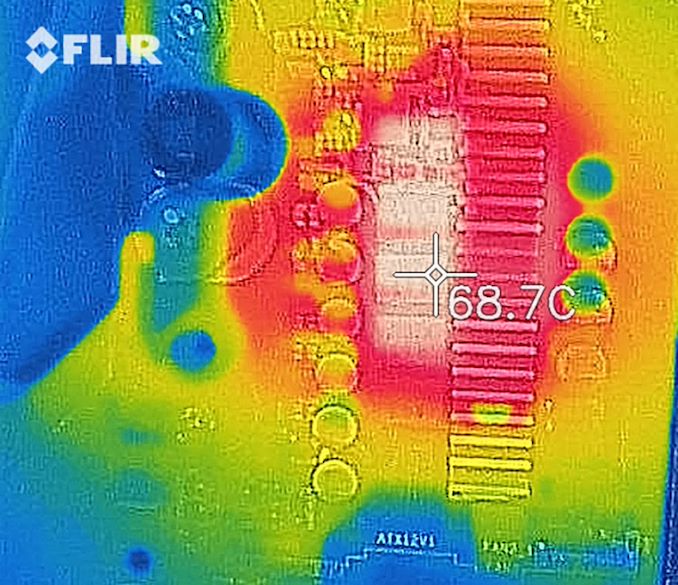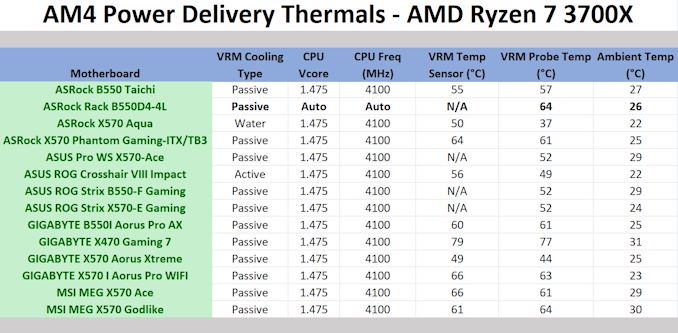ASRock Rack B550D4-4L Motherboard Review: B550 Goes Professional with BMC
by Gavin Bonshor on May 20, 2021 9:00 AM ESTPower Delivery Thermal Analysis
One of the most requested elements of our motherboard reviews revolves around the power delivery and its components. Aside from the quality of the components and its capability for overclocking to push out higher clock speeds which in turn improves performance, is the thermal capability of the cooling solutions implemented by manufacturers. While almost always fine for users running processors at default settings, the cooling capability of the VRMs isn't something that users should worry too much about, but for those looking to squeeze out extra performance from the CPU via overclocking, this puts extra pressure on the power delivery and in turn, generates extra heat. This is why more premium models often include heatsinks on its models with better cooling designs, heftier chunks of metal, and in some cases, even with water blocks.

The CPU section of the 6-phase (4+2) power delivery on the ASRock Rack B550D4-4L motherboard
Testing Methodology
Out method of testing out if the power delivery and its heatsink are effective at dissipating heat, is by running an intensely heavy CPU workload for a prolonged method of time. We apply an overclock which is deemed safe and at the maximum that the silicon on our AMD Ryzen 7 3700X processor allows. We then run the Prime95 with AVX2 enabled under a torture test for an hour at the maximum stable overclock we can which puts insane pressure on the processor. We collect our data via three different methods which include the following:
- Taking a thermal image from a birds-eye view after an hour with a Flir Pro thermal imaging camera
- Securing two probes on to the rear of the PCB, right underneath CPU VCore section of the power delivery for better parity in case the first probe reports a faulty reading
- Taking a reading of the VRM temperature from the sensor reading within the HWInfo monitoring application
The reason for using three different methods is that some sensors can read inaccurate temperatures, which can give very erratic results for users looking to gauge whether an overclock is too much pressure for the power delivery handle. With using a probe on the rear, it can also show the efficiency of the power stages and heatsinks as a wide margin between the probe and sensor temperature can show that the heatsink is dissipating heat and that the design is working, or that the internal sensor is massively wrong. To ensure our probe was accurate before testing, I binned 10 and selected the most accurate (within 1c of the actual temperature) for better parity in our testing.
For thermal image, we use a Flir One camera as it gives a good indication of where the heat is generated around the socket area, as some designs use different configurations and an evenly spread power delivery with good components will usually generate less heat. Manufacturers who use inefficient heatsinks and cheap out on power delivery components should run hotter than those who have invested. Of course, a $700 flagship motherboard is likely to outperform a cheaper $100 model under the same testing conditions, but it is still worth testing to see which vendors are doing things correctly.
Thermal Analysis Results

We measured 68.7ºC on the hottest part of the power delivery during our testing
The power delivery on the B550D4-4L is using premium components but isn't adequately cooled for performance users. It features a 4+2 phase power delivery, which is driven by an Intersil ISL69247 PWM controller, which is capable of handling up to eight channels. The CPU section is located on the opposite side of the board from the SoC area, and ASRock Rack includes four Renesas ISL99390 90 A power stages designed to deliver a maximum of 360 A to the processor. The SoC section is using two Renesas ISL99390 90 A power stages.
The ASRock B550D4-4L motherboard is using premium components for its 6-phase power delivery, with each phase consisting of a Renesas ISL99390 90 A power stage. It is controlled by an Intersil ISL69247 PWM controller operating in a 4+2 configuration. Boards such as these are typically built to specification, without the glorification of high-end components and over-engineered designs. As a result of the lack of optimal heatsinks designed to keep it cool, we only tested the board at stock settings. Despite offering some overclocking functions in the firmware via the way of AMD's own enhancements, and even boldly including an 'LN2 mode', the heatsinks cooling the power delivery aren't substantial enough to support overclocking. The heatsinks themselves are slithered thin, with little to no mass, and are standard on professional-focused models such as this.
As we tested the B550D4-4L at default settings, and we saw acceptable power delivery thermal for a board of this caliber. We observed temperatures of 62 and 64 degrees Celsius respectively from our pair of K-type thermocouples, with the hottest part of the CPU section of the power delivery coming in with a maximum temperature of 68.7 degrees Celsius. The board doesn't include an integrated power delivery thermal sensor, so we couldn't take this reading.
Although the B550D4-4L does include options for customization of Precision Boost Overdrive, power settings, and basic overclocking functions, our results suggest that it wouldn't be wise, nor prudent to push any processor on this board further than the default settings. Our testing shows that when compared to other AM4 boards we tested, the temperatures at default settings were similar to the board's tested with a CPU VCore of 1.475 and overclocked all-cores to 4.1 GHz. This is another testament as to why this board isn't really suitable for overclocking.











73 Comments
View All Comments
fmyhr - Thursday, May 20, 2021 - link
While this is true, AMD and motherboard manufacturers are distressingly cagey about whether ECC and ECC error reporting actually work. If you care about this, you need to do your own searches. There have been cases of ECC support being added or removed on successive motherboard BIOS revisions. The different mainstream mfgs have different attitudes regarding ECC RAM: MSI pretty much ignores it, Gigabyte says they support ECC on _some_ boards, Asus seems somewhat better, and ASRock appears to be the best bet. If only Supermicro would give us a non-Threadripper Ryzen board...AntonErtl - Friday, May 21, 2021 - link
AFAIK all ASUS (as well as all Asrock) boards support ECC. We have several servers with (working) ECC with Ryzen CPUs (without Pro): 1600X, 1800X, 3700X, 3900X, 5800X. If AMD sold the Pro models in retail and guaranteed ECC functionality, we would be willing to pay a little extra for that. As for the Pro models, I once compared the specification of one with the corresponding non-Pro model, and wrt ECC they were the same. Can anyone name a Pro model where AMD guarantees more ECC functionality?mode_13h - Friday, May 21, 2021 - link
The difference between ECC support of Pro and non-Pro CPUs is supposedly that AMD only tests and guarantees it on the Pros. For the non-Pro CPUs, it's up to the motherboard vendor to test and support.As for APUs, AMD disables ECC support on the non-Pro APUs. I guess that's because the main customers for APUs with ECC are corporations, and so it's like a favor to big OEMs, giving them a lock on the corporate market (since the Pro versions seem to be EOM-only).
mode_13h - Friday, May 21, 2021 - link
> EOM-onlytypo: should be OEM-only.
Slash3 - Friday, May 21, 2021 - link
Correct. The board does indeed support ECC in that way. Gavin misinterpreted the specifications; no idea why, as it is quite clear.https://www.asrockrack.com/general/productdetail.a...
"DDR4 288-pin ECC*/non-ECC UDIMM
* For AMD Ryzen Desktop Processors with Radeon Graphics, ECC support is only with Processors with PRO technologies."
Non-Pro APUs have always been the exception, and do not support ECC on any platform.
Jorgp2 - Friday, May 21, 2021 - link
>Uhh.. ECC memory works just fine with bog standard (aka "not Pro") Ryzen CPU's and has LITERALLY since their launch in 2017.I don't think you understand what kind of board this is.
If the data sheet says it only supports ECC for select SKUs, then it only supports ECC for select SKUs.
There is no halfway for the target market.
leexgx - Friday, June 18, 2021 - link
Ecc functionality still works even with the non-pro CPUs (just official stance is it doesn't work even thought it does, not like Intel where if its an i5 or higher ecc automatically doesn't work) ddr5 is going to change this problem with Intel as ecc is baked into ddr5 and can't be disabled and sold "as a enterprise" featureMeJ - Friday, May 21, 2021 - link
"The B550D4-4L also doesn't include integrated audio, so users looking to build an audio workstation will need to rely on external audio controllers."With respect, this comment is illogical. I have never heard of any DAWorkstation using on-board audio, and don't ever expect to. NOT having on-board audio to disable is a major advantage for a DAW. Also, the DPC issues here are perhaps characteristic of early drivers. There is no inherent reason I can see for this board to have worse performance than others with the same chipset... Is there? I agree that 10G would be preferred for a DAW.
mode_13h - Friday, May 21, 2021 - link
Lol. Yeah, integrated audio on server boards that even have it tends to be a minimal implementation, with lots of crosstalk and interference.mode_13h - Friday, May 21, 2021 - link
ASPEED BMCs are such garbage. This has the same ARM11 core as a first gen Raspberry Pi. Just imagine how slow software rendering is on such a core, and that's the graphics performance you get on these things.I have an ASRock board with one of these BMCs, and 2D graphics even feels slow at 1024x768 (which is the resolution that the EDID of my analog KVM seems to advertise, even though the monitor is higher).